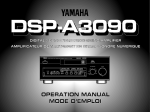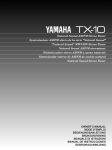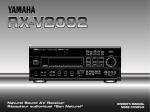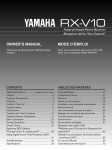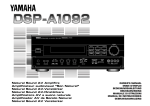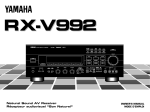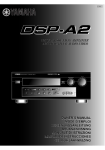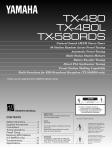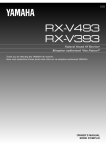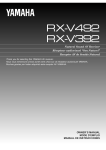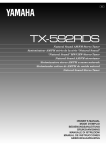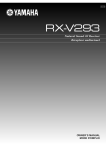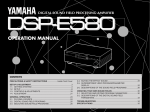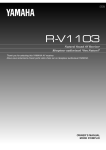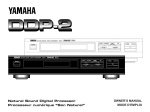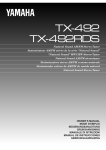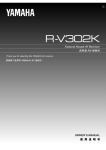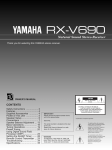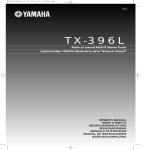Download Yamaha RX
Transcript
NATURAL SOUND CINEMA DSP 7ch AV RECEIVER RX–V2092 DIGITAL/ PRO LOGIC ENHANCED MOVIE THEATER TV SPORTS STADIUM DISCO ROCK CONCERT JAZZ CLUB CHURCH CONCERT HALL EFFECT VOLUME l6 VCR 2 VCR 1 20 DVD/LD l2 28 8 POWER A/B/C/D/E 1 2 3 4 5 6 VIDEO AUX TAPE (MD) TV/DBS TUNER PHONO CD 4 40 2 60 8 7 0 –dB l ON OFF 0 l 2 3 4 A PHONES SPEAKERS 4 5 B BASS TONE EXTENSION BYPASS l 2 3 5 0 l 2 l 2 3 3 4 4 5 5 0 SOURCE DVD/LD l 2 2 3 3 4 4 L5 5R TAPE (MD) TV/DBS TUNER VCR 1 CD VCR 2 FM/AM MAN’L/AUTO FM TREBLE BALANCE SET MENU VIDEO AUX MEMORY BASS DELAY/C/R DOWN TUNING UP /F/SWFR AUTO/MAN’L MONO PHONO REC OUT Natural Sound AV Receiver Récepteur audiovisuel “Son Naturel” EDIT TUNING MODE S VIDEO VIDEO L AUDIO R VIDEO AUX OWNER’S MANUAL MODE D’EMPLOI SAFETY INSTRUCTIONS CAUTION RISK OF ELECTRIC SHOCK DO NOT OPEN CAUTION: TO REDUCE THE RISK OF ELECTRIC SHOCK, DO NOT REMOVE COVER (OR BACK), NO USER-SERVICEABLE PARTS INSIDE, REFER SERVICING TO QUALIFIED SERVICE PERSONNEL. • Explanation of Graphical Symbols The lightning flash with arrowhead symbol, within an equilateral triangle, is intended to alert you to the presence of uninsulated “dangerous voltage” within the product’s enclosure that may be of sufficient magnitude to constitute a risk of electric shock to persons. The exclamation point within an equilateral triangle is intended to alert you to the presence of important operating and maintenance (servicing) instructions in the literature accompanying the appliance. WARNING TO REDUCE THE RISK OF FIRE OR ELECTRIC SHOCK, DO NOT EXPOSE THIS UNIT TO RAIN OR MOISTURE. 1 Read Instructions – All the safety and operating instructions should be read before the unit is operated. 2 Retain Instructions – The safety and operating instructions should be retained for future reference. 3 Heed Warnings – All warnings on the unit and in the operating instructions should be adhered to. 4 Follow Instructions – All operating and other instructions should be followed. 5 Water and Moisture – The unit should not be used near water – for example, near a bathtub, washbowl, kitchen sink, laundry tub, in a wet basement, or near a swimming pool, etc. 6 Carts and Stands – The unit should be used only with a cart or stand that is recommended by the manufacturer. 6A A unit and cart combination should be moved with care. Quick stops, excessive force, and uneven surfaces may cause the unit and cart combination to overturn. 7 Wall or Ceiling Mounting – The unit should be mounted to a wall or ceiling only as recommended by the manufacturer. 8 Ventilation – The unit should be situated so that its location or position does not interfere with its proper ventilation. For example, the unit should not be situated on a bed, sofa, rug, or similar surface, that may block the ventilation openings; or placed in a builtin installation, such as a bookcase or cabinet that may impede the flow of air through the ventilation openings. 9 Heat – The unit should be situated away from heat sources such as radiators, stoves, or other appliances that produce heat. 10 Power Sources – The unit should be connected to a power supply only of the type described in the operating instructions or as marked on the unit. 11 Power-Cord Protection – Powersupply cords should be routed so that they are not likely to be walked on or pinched by items placed upon or against them, paying particular attention to cords at plugs, convenience receptacles, and the point where they exit from the unit. 14 Object and Liquid Entry – Care should be taken so that objects do not fall into and liquids are not spilled into the inside of the unit. 15 Damage Requiring Service – The unit should be serviced by qualified service personnel when: A. The power-supply cord or the plug has been damaged; or B. Objects have fallen, or liquid has been spilled into the unit; or C. The unit has been exposed to rain; or D. The unit does not appear to operate normally or exhibits a marked change in performance; or E. The unit has been dropped, or the cabinet damaged. 16 Servicing – The user should not attempt to service the unit beyond those means described in the operating instructions. All other servicing should be referred to qualified service personnel. 12 Cleaning – The unit should be cleaned only as recommended by the manufacturer. 17 Power Lines – An outdoor antenna 13 Nonuse Periods – The power cord of 18 Grounding or Polarization – the unit should be unplugged from the outlet when left unused for a long period of time. should be located away from power lines. Precautions should be taken so that the grounding or polarization is not defeated. Outdoor Antenna Grounding – If an outside antenna is connected to this unit, be sure the antenna system is grounded so as to provide some protection against voltage surges and built-up static charges. Article 810 of the National Electrical Code, ANSI/NFPA 70, provides information with regard to proper grounding of the mast and supporting structure, grounding of the lead-in wire to an antenna discharge unit, size of grounding conductors, location of antenna discharge unit, connection to grounding electrodes, and requirements for the grounding electrode. Note to CATV system installer: This reminder is provided to call the CATV system installer’s attention to Article 820-40 of the NEC that provides guidelines for proper grounding and, in particular, specifies that the cable ground shall be connected to the grounding system of the building, as close to the point of cable entry as practical. ANTENNA LEAD IN WIRE GROUND CLAMP ANTENNA DISCHARGE UNIT (NEC SECTION 810–20) ELECTRIC SERVICE EQUIPMENT This device is a composite system. The digital device component may not cause harmful interference. FCC INFORMATION (for US customers only) 1. IMPORTANT NOTICE : DO NOT MODIFY THIS UNIT! This product, when installed as indicated in the instructions contained in this manual, meets FCC requirements. Modifications not expressly approved by Yamaha may void your authority, granted by the FCC, to use the product. 2. IMPORTANT : When connecting this product to accessories and/or another product use only high quality shielded cables. Cable/s supplied with this product MUST be used. Follow all installation instructions. Failure to follow instructions could void your FCC authorization to use this product in the USA. EXAMPLE OF ANTENNA GROUNDING MAST SPECIAL NOTES FOR FCC COMPOSITE DEVICE (for US customers only) GROUNDING CONDUCTORS (NEC SECTION 810–21) 3. NOTE : This product has been tested and found to comply with the requirements listed in FCC Regulations, Part 15 for Class “B” digital devices. Compliance with these requirements provides a reasonable level of assurance that your use of this product in a residential environment will not result in harmful interference with other electronic devices. This equipment generates/uses radio frequencies and, if not installed and used according to the instructions found in the users manual, may cause interference harmful to the operation of other electronic devices. Compliance with FCC regulations does not guarantee that interference will not occur in all installations. If this product is found to be the source of interference, which can be determined by turning the unit “OFF” and “ON”, please try to eliminate the problem by using one of the following measures: GROUND CLAMPS POWER SERVICE GROUNDING ELECTRODE SYSTEM (NEC ART 250. PART H) NEC – NATIONAL ELECTRICAL CODE We Want You Listening For A Lifetime (for US customers only) YAMAHA and the Electronic Industries Association’s Consumer Electronics Group want you to get the most out of your equipment by playing it at a safe level. One that lets the sound come through loud and clear without annoying blaring or distortion – and, most importantly, without affecting your sensitive hearing. Since hearing damage from loud sounds is often undetectable until it is too late, YAMAHA and the Electronic Industries Association’s Consumer Electronics Group recommend you to avoid prolonged exposure from excessive volume levels. Relocate either this product or the device that is being affected by the interference. Utilize power outlets that are on different branch (circuit breaker or fuse) circuits or install AC line filter/s. In the case of radio or TV interference, relocate/reorient the antenna. If the antenna lead-in is 300 ohm ribbon lead, change the lead-in to coaxial type cable. If these corrective measures do not produce satisfactory results, please contact the local retailer authorized to distribute this type of product. If you can not locate the appropriate retailer, please contact Yamaha Electronics Corp., U.S.A. 6660 Orangethorpe Ave, Buena Park, CA 90620. The above statements apply ONLY to those products distributed by Yamaha Corporation of America or its subsidiaries. English 19 For US customers only: Congratulations! You are the proud owner of a Yamaha Digital Sound Field Processing (DSP) System—an extremely sophisticated audio component. The DSP system takes full advantage of Yamaha’s undisputed leadership in the field of digital audio processing to bring you a whole new world of listening experiences. Follow the instructions in this manual carefully when setting up your system, and the DSP system will sonically transform your room into a wide range of listening environments—anything from a famous concert hall to a cozy jazz club. In addition, you get incredible realism from Dolby-Surround encoded video sources using the built-in Dolby Pro Logic Surround Decoder and Dolby Digital (AC-3) Decoder. Seven built-in channels of amplification on this model mean that no additional amplifiers are required to enjoy advanced digital sound field processing. Rather than tell you about the wonders of digital sound field processing, however, let’s get right down to the business of setting up the system and trying out its many capabilities. Please read this operation manual carefully and store it in a safe place for later reference. PRECAUTIONS 8. USE THIS UNIT PROPERLY To assure the finest performance, please read this manual carefully. Keep it in a safe place for future reference. Do not use force on switches, controls or connection wires. When moving the unit, first disconnect the power plug and the wires connected to other equipment. Never pull the wires themselves. 2. AVOID EXCESSIVE HEAT, HUMIDITY, DUST AND VIBRATION Keep the unit away from locations where it is likely to be exposed to high temperatures or humidity—such as near radiators, stoves, etc. Also avoid locations which are subject to excessive dust accumulation or vibration which could cause mechanical damage. 3. INSTALL THE UNIT IN WELL-VENTILATED CONDITION The openings on the cabinet assure proper ventilation of the unit. If these openings are obstructed, the temperature inside the cabinet will rise rapidly. Therefore, avoid placing objects against these openings, and install the unit in well-ventilated condition. Make sure to allow a space of at least 10 cm behind, 20 cm on the both sides and 30 cm above the top panel of the unit. Otherwise it may not only damage the unit, but also cause fire. 4. KEEP THE AC POWER PLUG DISCONNECTED DURING VACATION ETC. When not planning to use this unit for long periods of time (ie., vacation, etc.), disconnect the AC power plug from the wall outlet. 5. AVOID PHYSICAL SHOCKS Strong physical shocks to the unit can cause damage. Handle it with care. 6. DO NOT OPEN THE UNIT OR ATTEMPT REPAIRS OR MODIFICATIONS YOURSELF 9. TAKE CARE OF THE VOLUME CONTROL SETTING Voltage Selector (General Model only) The voltage selector on the rear panel of this unit must be set for your local mains voltage BEFORE plugging into the AC mains supply. Voltages are 110/120/220/240 AC, 50/60 Hz. Always set the VOLUME control to “– ∞” before starting the audio source play. Increase the volume gradually to an appropriate level after playback has been started. WARNING 10. HANDLE CABLES CAREFULLY CAUTION (FOR CANADA MODEL) TO PREVENT ELECTRIC SHOCK, MATCH WIDE BLADE OF PLUG TO WIDE SLOT AND FULLY INSERT. Always plug and unplug cables—including the AC cord—by gripping the connector, not the cord. 11. PREVENT LIGHTNING DAMAGE To prevent lightning damage, disconnect the AC power plug and disconnect the antenna cable when there is an electrical storm. English 1. PLEASE READ THIS MANUAL CAREFULLY To reduce the risk of fire or electric shock, do not expose this unit to rain or moisture. FOR CANADIAN CUSTOMER THIS CLASS B DIGITAL APPARATUS MEETS ALL REQUIREMENTS OF THE CANADIAN INTERFERENCECAUSING EQUIPMENT REGULATIONS. 12. CLEAN WITH A SOFT DRY CLOTH Never use solvents such as benzine or thinner to clean the unit. Wipe clean with a soft, dry cloth. The apparatus is not disconnected from the AC power source as long as it is connected to the wall outlet, even if the apparatus itself is turned off. 13. USE THIS UNIT WITH THE CORRECT VOLTAGE The voltage to be used must be the same as that specified on this unit. Using this unit with a higher voltage than that which is specified is dangerous and may result in a fire or other type of accident causing damage. YAMAHA will not be held responsible for any damage resulting from use of this unit with a voltage other than that which is specified. This product contains no user-serviceable parts. Refer all maintenance to qualified Yamaha service personnel. Opening the unit and/or tampering with the internal circuitry will make servicing difficult and will endanger you and your unit. IMPORTANT! 7. MAKE SURE POWER IS OFF BEFORE MAKING OR REMOVING CONNECTIONS Serial No.: Always turn power OFF prior to connecting or disconnecting cables. This is important to prevent damage to the unit itself as well as other connected equipment. The serial number is located on the rear of the unit. Retain this Owner’s Manual in a safe place for future reference. Please record the model and serial number of your unit in the space below. WARNING Do not change the IMPEDANCE SELECTOR switch setting while the power to this unit is on, otherwise this unit may be damaged. IF THIS UNIT FAILS TO TURN ON WHEN THE POWER SWITCH IS PRESSED The IMPEDANCE SELECTOR switch may not be set to either end closely. If so, set the switch to either end closely. VOLTAGE SELECTOR Model: AC OUTLETS SWITCHED I20V 60Hz I00W MAX. TOTAL IMPEDANCE SELECTOR A B CENTER C OR D: 4ΩMIN./ SPEAKER SET SPEAKER MODE C D: 4ΩMIN./ SPEAKER SET SPEAKER MODE REAR 6ΩMIN./ SPEAKER MAIN A OR B: 4ΩMIN./ SPEAKER A B: 8ΩMIN./ SPEAKER FRONT EFFECT: 6ΩMIN./ SPEAKER CENTER C OR D: 8ΩMIN./ SPEAKER SET SPEAKER MODE C D: 4ΩMIN./ SPEAKER SET SPEAKER MODE REAR 8ΩMIN./ SPEAKER MAIN A OR B: 8ΩMIN./ SPEAKER A B: 6ΩMIN./ SPEAKER FRONT EFFECT: 8ΩMIN./ SPEAKER IMPEDANCE SELECTOR (General model) 1 CONTENTS SAFETY INSTRUCTIONS...........................................Inside the cover PRECAUTIONS ...................................................................................1 GETTING STARTED ...........................................................................3 FEATURES ..........................................................................................5 SPEAKER SETUP.............................................................................10 CONTROLS & THEIR FUNCTIONS .................................................13 FRONT PANEL................................................................................13 DISPLAY PANEL .............................................................................16 CONNECTIONS.................................................................................18 REAR PANEL PARTS AND THEIR FUNCTIONS..........................18 REAR PANEL SWITCH AND CONTROL SETTINGS...................22 GENERAL INSTRUCTIONS FOR CONNECTIONS .....................22 CONNECTING AUDIO/VIDEO SOURCE EQUIPMENT TO THIS UNIT .................................................................................23 ANTENNA CONNECTIONS...........................................................27 CONNECTING SPEAKER SYSTEMS...........................................30 SELECTING THE OUTPUT MODES SUITABLE FOR YOUR SPEAKER SYSTEM .......................................................................35 CONNECTING AND CONTROLLING ROOM 2 EQUIPMENT.......38 CONNECTIONS..............................................................................38 ROOM 2 REMOTE CONTROL UNIT .............................................39 SPEAKER BALANCE ADJUSTMENT ............................................41 ADJUSTMENTS IN THE “SET MENU” MODE................................43 GENERAL OPERATION ...................................................................46 PLAYING A SOURCE .....................................................................46 RECORDING A SOURCE TO AUDIO/VIDEO TAPE (OR DUBBING FROM A TAPE TO ANOTHER).............................48 2 TUNING OPERATIONS.....................................................................50 AUTOMATIC TUNING .....................................................................50 MANUAL TUNING...........................................................................50 PRESET TUNING ..............................................................................51 MANUAL PRESET TUNING...........................................................51 AUTOMATIC PRESET TUNING .....................................................52 EXCHANGING PRESET STATIONS..............................................53 SELECTING SOUND FIELD PROGRAMS......................................54 CANCELING THE EFFECT SOUND .............................................55 DESCRIPTIONS OF THE SOUND FIELD PROGRAMS ..............56 ADJUSTING DELAY TIME AND EACH SPEAKER OUTPUT LEVEL..............................................................................................59 SETTING THE SLEEP TIMER...........................................................61 REMOTE CONTROL UNIT ...............................................................62 BASIC OPERATIONS (When the lid is open) ................................62 LEARNING NEW CONTROL FUNCTIONS (When the lid is open) .........................................................................................................64 USING OPERATION CONTROL KEYS (When the lid is closed) .........................................................................................................67 MACRO OPERATIONS (When the lid is closed) ...........................70 LEARNING A NEW FUNCTION.....................................................73 MAKING A NEW MACRO...............................................................75 CLEARING LEARNED FUNCTIONS.............................................76 TROUBLESHOOTING ......................................................................78 SPECIFICATIONS .............................................................................81 GETTING STARTED Installing the Remote Control Unit Batteries If you haven’t already done so, carefully remove this unit and its accessories from the box and wrapping material.You should find the unit itself and the following accessories. Since the remote control unit will be used for many of this unit’s control operations, you should begin by installing the supplied batteries. English Unpacking 1. Turn the remote control unit over and slide the battery compartment cover downward in the direction of the arrow. Batteries 2. Insert the batteries (LR6, AA, UM-3 type), being careful to align them with the polarity markings on the inside of the battery compartment. 3. Close the battery compartment cover. Remote control unit (for the main room) User function stickers Remote control (for the main room) Room 2 remote control unit 2 1 3 Room 2 remote control unit Indoor FM antenna 2 AM loop antenna Antenna adapter (U.S.A. and Canada models only) 1 3 3 * For the remote control unit for the main room only After you insert batteries (or you exchange batteries with new ones), press the RESET button before using the remote control unit. RESET button Notes about the Remote Control Unit ● When you notice that remote control operation has become erratic, or the distance from which the remote control will function has decreased, it’s time to replace the batteries. Always replace all batteries at the same time. ● This remote control uses an advanced, highly directional infrared beam. Be sure to aim the remote control directly at the remote control sensor on the main unit when operating. Open/close the control door Remote control transmitter operation range When it is not necessary to operate controls inside the control door, close the door. To open the door Remote control sensor Within approximately 6 m (19.7 feet) 30° 30° To close the door Notes ● There should be no large obstacles between the remote control unit and the main unit. ● If the remote control sensor is directly illuminated by strong lighting (especially an inverter type of fluorescent lamp etc.), it might cause the remote control unit to work incorrectly. In this case, reposition the main unit to avoid direct lighting. 4 FEATURES In addition, this unit incorporates a Dolby Pro Logic Surround decoder and Dolby Digital (AC-3) decoder for multi-channel sound reproduction of Dolby Surround encoded video sources. The operation of the Dolby Pro Logic Surround or Dolby Digital (AC-3) decoder can be controlled by selecting a corresponding DSP program including combined operations of the Yamaha DSP and the Dolby Pro Logic Surround or Dolby Digital (AC-3) decoder. Digital Sound Field Processing What is it that makes live music so good? Today’s advanced sound reproduction technology lets you get extremely close to the sound of a live performance, but chances are you’ll still notice something missing, the acoustic environment of the live concert hall. Extensive research into the exact nature of the sonic reflections that create the ambience of a large hall has made it possible for Yamaha engineers to bring you this same sound in your own listening room, so you’ll feel all the sound of a live concert. What’s more, our technicians, armed with sophisticated measuring equipment, have even made it possible to capture the acoustics of a variety of actual concert halls, jazz clubs, theaters, etc. from around the world, to allow you to accurately recreate any one of these live performance environments, all in your own home. English This unit incorporates a sophisticated, multi-program digital sound field processor. The processor allows you to electronically expand and change the shape of the audio sound field from both audio and video sources, creating a theater-like experience in your listening room. This unit has a total of 10 digital sound field processor (DSP) modes. You can create an excellent audio sound field by selecting a suitable sound field (this will, of course, depend on what you will be listening to), and adding desired adjustments. 5 6 Dolby Pro Logic Surround Dolby Digital (AC-3) This unit employs a Dolby Pro Logic Surround decoder similar to professional Dolby Stereo decoders used in many movie theaters. By using the Dolby Pro Logic Surround decoder, you can experience the dramatic realism and impact of Dolby Surround movie theater sound in your own home. Dolby Pro Logic employs a four channel five speaker system. The Pro Logic Surround system divides the input signal into four levels: the left and right main channels, the center channel (used for dialog), and the rear surround sound channels (used for sound effects, background noise, and other ambient noises). The center channel allows listeners seated in even less-than-ideal positions to hear the dialog originating from the action on the screen while experiencing good stereo imaging. Dolby Surround is encoded on the sound track of pre-recorded video tapes, laser discs, and some TV/cable broadcasts. When you play a source encoded with Dolby Surround on this unit, the Dolby Pro Logic Surround decoder decodes the signal and distributes the surround-sound effects. The built-in Dolby Digital (AC-3) Decoder leads you into a totally new sound experiences. This Dolby Pro Logic Surround Decoder employs a digital signal processing system. This system improves the stability of sound at each channel and crosstalk between channels, so that positioning of sounds around the room is more accurate compared with conventional analog signal processing systems. Compared to Dolby Pro Logic that is referred to a “3/1” system (left front, center, right front and just one surround channel), Dolby Digital (AC-3) features two surround channels, called stereo or split surrounds, each offering the same full range fidelity as the three front channels. In addition, this unit features a built-in automatic input balance control. This always assures you the best performance without manual adjustment. Sound of wide dynamic range reproduced by the five full range channels presents listeners much excitement that has never been experienced before. Precise sound orientation by the discrete digital sound processing expands realism that the original movie possesses. Dolby Digital (AC-3) is a new generation of multi-channel digital audio technology, or the newest spatial sound processing format developed for 35 mm film-movies by employing a new kind of low bit-rate audio coding. Dolby Digital (AC-3) is a digital surround sound system that provides completely independent multi-channel audio to consumers. In multi-channel form, Dolby Digital (AC-3) provides five full range channels in what is sometimes referred to as a “3/2” configuration: three front channels (left, center and right), plus two surround channels. A sixth bass-only effect channel is also provided for output of LFE (low frequency effect), or low bass effects that are independent of other channels. This channel is counted as 0.1, thus giving rise to the term 5.1 channels in total. Manufactured under license from Dolby Laboratories Licensing Corporation. “Dolby”, “AC-3”, “Pro Logic”, and the double-D symbol are trademarks of Dolby Laboratories Licensing Corporation. Copyright 1992 Dolby Laboratories, Inc. All rights reserved. The following original functions make the surround-sound effect of Dolby Digital (AC-3) become the most suitable for your audio system and the listening conditions. Dolby Surround + DSP (CINEMA DSP) Dolby Surround sound system shows its full ability in a large movie theater, because movie sounds are originally designed to be reproduced in a large movie theater using many speakers. It is difficult to create a sound environment similar to that of a movie theater in your listening room, because the room size, materials of inside walls, the number of speakers, etc. of your listening room is much different from those of a movie theater. English Laser Disc is a home audio format that could benefit from Dolby Digital (AC-3). In the near future, Dolby Digital (AC-3) will also be applied to DBS, CATV, DVD and HDTV. The ongoing release of Dolby Stereo Digital theatrical films now underway will provide an immediate source of Dolby Digital (AC-3) encoded video software. Yamaha DSP technology made it possible to present you with nearly the same sound experience as that of a large movie theater in your listening room by compensating for lack of presence and dynamics in your listening room with its original digital sound fields combined with Dolby Surround sound field. CINEMA DSP 7ch ● ● ● Dynamic range (sound scale) of source can be changed so that it will be suitable for the listening conditions. Output of low bass from any channel can be assigned to either the MAIN SPEAKERS terminals or SUBWOOFER terminals to maximize system performance. Output of LFE can be assigned to either the MAIN SPEAKERS terminals or SUBWOOFER terminals to maximize system performance. The YAMAHA “CINEMA DSP” logo indicates those programs are created by the combination of Dolby Surround and YAMAHA DSP technology. 7 Dolby Pro Logic + 2 Digital Sound Fields Dolby Digital (AC-3) + 3 Digital Sound Fields Digital sound fields are created on the presence side and the rear surround side of the Dolby Pro Logic Surround-decoded sound field respectively. They create a wide acoustic environment and emphasize surround-effect in the room, letting you feel much presence as if you are watching a movie in a popular Dolby Stereo theater. Digital sound fields are created on the presence side and the independent left and right surround sides of the Dolby Digital (AC3)-decoded sound field respectively. They create a wide acoustic environment and much surround effect in the room without losing high channel separation. With wide dynamic range of Dolby Digital (AC-3) sound, this sound field combination lets you feel as if you are watching a movie in the newest Dolby Stereo Digital theater. This will be the most ideal home theater sound at the present time. This combination is available when the sound field program No. 2, No. 3 or No. 4 is selected, and the input signal of source is analog, PCM audio or encoded with the Dolby Digital (AC-3) in 2channels. 8 This combination is available when the sound field program No. 2, No. 3 or No. 4 is selected, and the input signal of source is encoded with the Dolby Digital (AC-3) (except in 2-channels). If you connect your video cassette recorder, LD player, video monitor, etc. to this unit, you can take advantage of this unit’s capability to display program titles and information for various setting changes and adjustments on your video monitor’s screen. This information will be superimposed over the video image. English Video superimpose If there is no video source connected or it is turned off, the information will be displayed over a blue colored background. TEST DSP EFFECT LEVEL / FRONT 0dB NOTE: The program titles and other information are also displayed on the display panel of this unit. SPEAKERS A DSP 9 SPEAKER SETUP Setting Up Your Speaker System Use of the Center Dialog Speaker Is Recommended This unit has been designed to provide the best sound field quality with a full seven-speaker system setup, using two extra pairs of effect speakers to generate the sound field plus one center speaker for dialog. We therefore recommend that you use a sevenspeaker setup. A four-speaker system using only one pair of effect speakers for the sound field will still provide impressive ambience and effects, however, and may be a good way to begin with this unit. You can always upgrade to the full seven speaker system later. In the 4 or 5 speaker system, the Digital Sound Field Processing is still performed, but the main speakers are used for both the main channels and the front effect channels. When playing back a source with the DSP programs No. 1 through No. 4, or when the Dolby Digital (AC-3) is decoded with any DSP program used, if the source contains center-channel signals, dialog, vocals etc. are output from the center channel. Therefore, if you want to maximize the performance of your Audio/Video home theater system, it is recommended that you use a center channel speaker. If for some reason it is not practical to use a center speaker, it is possible to enjoy movie viewing without it. Best results, however, are obtained with the full system. Use of a Subwoofer Expands Your Sound Field It is also possible to further expand your system with the addition of a subwoofer and amplifier. The use of a subwoofer is effective not only for reinforcing bass frequencies from any or all channels, but also for reproducing the LFE (low frequency effect) sound with high fidelity when playing back a source with the Dolby Digital (AC-3) decoded. You may wish to choose the convenience of a Yamaha Active Servo Processing Subwoofer System, which has its own built-in power amplifier. 10 4 Speaker System 5 Speaker System 6 Speaker System 7 Speaker System Simplest system. Good for Audio/Video sources. Good for sound fields from 2channel stereo sources. This is the recommended speaker system, providing the best sound effects. You can enjoy widely diffused sound by only adding two additional speaker units at the rear. By the use of center speaker, center sounds (dialog, vocals etc.) are precisely localized. When a normal stereo source is played back with the sound field programs No. 5 through No. 10, a sound effect matching that of a 7speaker system can be obtained. The addition of front left and right effect speakers produces a more effective sound field. When a normal stereo source is played back with the sound field programs No. 5 through No. 10, using both sets of effect speakers (front and rear), reproduces the most effective sound field. When using the sound field programs No. 1 through No. 4 or when using any program with the Dolby Digital (AC-3) decoded, the center speaker provides precise center localization. FRONT MIX switch—Set to ON. (See page 22.) CENTER SPEAKER—Set to PHNTM. (See page 35.) FRONT MIX switch—Set to ON. (See page 22.) CENTER SPEAKER—Set to NRML or WIDE. (See page 35.) FRONT MIX switch—Set to OFF. (See page 22.) CENTER SPEAKER—Set to PHNTM. (See page 35.) FRONT MIX switch—Set to OFF. (See page 22.) CENTER SPEAKER—Set to NRML or WIDE. (See page 35.) English Four Possible Types of Speaker System Configurations Recommended 11 Speakers and Speaker Placement Your full seven-speaker system will require three speaker pairs: the MAIN SPEAKERS (your normal stereo speakers), the FRONT EFFECT SPEAKERS and the REAR SPEAKERS, plus the CENTER SPEAKER. You may also be using a subwoofer. The MAIN SPEAKERS should be high performance models and have enough power handling capacity to accept the maximum output of your audio system. Other speakers do not have to be equal to the MAIN SPEAKERS. For precise sound localization, however, it is ideal to use high performance models that can reproduce sounds in full range for the CENTER SPEAKER and the FRONT EFFECT and REAR SPEAKERS. Place the MAIN SPEAKERS in the normal position. Place the FRONT EFFECT SPEAKERS further apart than the MAIN SPEAKERS, on either side of and a few feet behind and above the MAIN SPEAKER pair. Main speaker Place the REAR SPEAKERS behind your listening position. They should be nearly six feet up from the floor. Subwoofer Place the CENTER SPEAKER precisely between the two MAIN SPEAKERS. (To avoid interference, keep the speaker above or below the television monitor, or use a magnetically shielded speaker.) If using a SUBWOOFER, such as a Yamaha Active Servo Subwoofer System, the position of the speaker is not so critical because low bass tones are not highly directional. 12 Front effect speaker Rear speaker Center speaker CONTROLS & THEIR FUNCTIONS 1 2 3 NATURAL SOUND 4 5 6 7 8 English FRONT PANEL CINEMA DSP 7ch AV RECEIVER RX–V2092 DIGITAL/ PRO LOGIC ENHANCED DISCO ROCK CONCERT MOVIE THEATER JAZZ CLUB TV SPORTS STADIUM CHURCH CONCERT HALL EFFECT VOLUME l6 VCR 2 VCR 1 20 DVD/LD l2 28 8 POWER A/B/C/D/E 1 2 3 4 5 6 7 VIDEO AUX TAPE (MD) TV/DBS TUNER PHONO CD 4 40 2 60 8 0 –dB l ON OFF 0 l 2 3 4 A PHONES 9 0 BASS TONE EXTENSION BYPASS AB C 0 l 2 3 4 5 l 2 3 4 5 B SPEAKERS l 2 3 DVD/LD l 2 3 4 4 5 SOURCE 0 2 3 4 L5 5 TAPE (MD) TV/DBS TUNER VCR 1 CD FM/AM MAN’L/AUTO FM TREBLE D BALANCE E SET MENU VIDEO AUX 5R MEMORY BASS DELAY/C/R DOWN TUNING UP /F/SWFR AUTO/MAN’L MONO PHONO VCR 2 F EDIT TUNING MODE REC OUT G HI K L N O J M S VIDEO VIDEO L AUDIO R VIDEO AUX P Q (General Model) * For control keys on the remote control unit, see pages 62 to 64. 13 1 POWER Switch Turns this unit on and off. * When you press this switch to turn the power on, you will hear a click and a sound of the built-in fan rotating for a moment. 2 Standby Indicator (Except U.S.A. and Canada models) While the power of this unit is on, pressing the (SYSTEM POWER) OFF key on the remote control unit switches this unit to the standby mode. In this mode, the standby indicator is illuminated. 3 Remote Control Sensor Signals from the remote control unit are received here. 4 Display Panel See pages 16 to 17. 5 DSP Program Selector Buttons Select a DSP program. When a button is pressed, the name of selected program lights up on the display panel. 6 Input Selector Buttons Selects an input source that you want to listen to (and watch). 7 EFFECT Switch Normally ON, this switch can be turned OFF to disable output from the center and effect speakers so that the sound becomes normal 2-channels. * Even if this switch is off, when the Dolby Digital (AC-3) is decoded, signals at all channels are distributed to the main channels and output from the main speakers. 8 Master VOLUME Control Simultaneously controls volume level at all outputs: front effect, main, rear effect, center, and subwoofer. (This does not affect REC OUT level.) * When the volume is decreased by pressing the MUTE key on the remote control unit, the indicator on the master VOLUME control flashes on and off. 9 PHONES Jack When you listen with headphones, connect the headphones to the PHONES jack. You can listen to the sound to be output from the main speakers through headphones. When listening with headphones privately, set both the SPEAKERS A and B switches to the OFF position and switch off the digital sound field processor (so that no DSP program name is illuminated on the display panel) by pressing the EFFECT switch. 0 SPEAKERS Switches Set the switch A or B (or both A and B) for the main speakers (connected to this unit) you will use to the ON position. Set the switch for the main speakers you will not use to the OFF position. Selected main speakers are shown by the lighting of “SPEAKERS A” and/or “SPEAKERS B” on the display panel. A A/B/C/D/E Switch Press this switch to select a desired group (A–E) of preset stations. B BASS EXTENSION Switch When pressed inward (ON), boosts bass frequency response at the main left and right channels while maintaining overall tonal balance. If you do not have a subwoofer, the use of this switch will be effective to reinforce the bass frequencies. 14 When this switch is pressed inward (ON), the input signal does not pass through the tone (BASS and TREBLE) control circuitry so that it is unaffected by the tone control circuitry. Use this switch to obtain pure sound and to check the tone control setting. Press this switch to release it outward (OFF) to use the tone control circuitry. D BASS and TREBLE Controls Adjust low and high frequency response respectively for the main channels only. E BALANCE Control Adjusts the left and right output volume to the Main Speakers to compensate for sound imbalance caused by speaker positions or listening room conditions. F Preset Station Number Selector Buttons Select a preset station number (1 to 8). G REC OUT Selector Selects the source to be recorded to a tape deck or VCR independently of the setting of the input selector buttons. However, when set to the SOURCE position, the setting of the input selector buttons decides the source to be recorded to a tape deck or VCR. H FM/AM Switch Press this switch to switch the reception band to FM or AM. I MEMORY (MAN’L/AUTO FM) Button When this button is pressed, the MEMORY indicator flashes for about 5 seconds. During this period, select a desired preset station number by pressing the corresponding preset station number selector button to enter the displayed station into the memory. When this button is pressed and held for about 3 seconds, the automatic preset tuning begins. (Refer to page 52 for details.) J TUNING DOWN/UP Button Used for tuning. Press the “UP” side to tune in to higher frequencies, and press the “DOWN” side to tune in to lower frequencies. English C TONE BYPASS switch K EDIT Button This button is used to exchange the places of two preset stations with each other. L TUNING MODE (AUTO/MAN’L MONO) Switch Press this switch to switch the tuning mode to automatic or manual. To select the automatic tuning mode, press this switch so that “AUTO TUNING” lights up on the display panel. To select the manual tuning mode, press this switch so that “AUTO TUNING” goes off. M DELAY/C/R/F/SWFR Switch Whenever pressed, selects the item of changing delay time, center speaker output level, rear speaker output level, front effect speaker output level and subwoofer output level in turn. * Depending on a mode of this unit, the number of selections is reduced. For example, when the built-in digital sound field processor (including the Dolby Pro Logic Decoder or the Dolby Digital (AC-3) Decoder) is off, only the item for changing subwoofer output level can be selected. N –/+ Button Adjusts the level of item selected by pressing the DELAY/C/R/F/SWFR switch. Moreover, performs setting changes and adjustments for functions selected by pressing the SET MENU switch. O SET MENU Switch Whenever pressed, selects functions in the SET MENU mode. 15 P Auxiliary Input Jacks (VIDEO AUX) Connect an auxiliary video or audio unit such as a camcorder to these jacks. If the connected video unit has a S video output terminal, connect it to the S VIDEO jack to obtain a high resolution picture. The unit connected to these jacks can be selected by the corresponding input selector button and REC OUT selector. Q Control Door See page 4 for how to open and close the control door. DISPLAY PANEL 1 2 3 4 ROOM 2 AM FM PRESET DIGITAL kHz MHz ENHANCED 70 mm mS dB MEMORY TAPE 2 MONITOR AUTO TUNING SPEAKERS SPEAKERS A B ROOM 2 CONTROL 56 7 8 STEREO PCM 0 20 40 60 9 0 1 Preset Station Number Display Shows the selected preset station number (1 to 8) and its group (A to E). 2 ROOM 2 Indicator Lights up when you switch the input source for the second room by using the Room 2 remote control unit in the main room. 16 DIGITAL DIGITAL DSP I00 A B PRO LOGIC SLEEP C 3 Input Source/Station Frequency Display Shows the currently selected input source, or the currently selected station frequency and the band (FM or AM) when this unit is in the tuner input source mode. 4 Multi-informatiom Display Shows the currently selected DSP program, or information for several adjustments or setting changes made on this unit. When the MEMORY button is pressed, this indicator flashes for about 5 seconds. During this period, the displayed station can be programmed to the memory by using the A/B/C/D/E switch and the preset station number selector buttons. 0 Signal-level Meter Indicates the signal level of the received station. If multipath interference is detected, the indication decreases. A Digital Audio Input Signal Indicators When digital audio signals not encoded with the Dolby Digital (AC-3) are input to this unit, “PCM DIGITAL” lights up. When digital audio signals encoded with the Dolby Digital (AC-3) are input to this unit, “ DIGITAL” lights up. 6 AUTO TUNING Indicator Lights up when this unit is in the automatic tuning mode. 7 ROOM 2 CONTROL Indicator Lights up momentarily when the Room 2 remote control unit is used in the second room. 8 SPEAKERS A/B Indicators The indicator A or B which corresponds to the currently selected main speakers lights up. If both main speakers A or B are selected, both indicators light up. 9 STEREO Indicator Lights up when an FM stereo broadcast with sufficient signal strength is received. English 5 MEMORY Indicator B DIGITAL, DSP and PRO LOGIC indicators “ DIGITAL” lights up when the built-in Dolby Digital (AC-3) Decoder is on and the signals of selected source encoded with the Dolby Digital (AC-3) is not in 2-channels. “DSP” lights up when the built-in digital sound field processor is on, and “ PRO LOGIC” lights up when the built-in Dolby Pro Logic Surround Decoder is on. Depending on the selected DSP program, both “ DIGITAL” and “DSP”, or both “DSP” and “ PRO LOGIC” will light up. C SLEEP Indicator Lights up while the built-in SLEEP timer is functioning. 17 CONNECTIONS REAR PANEL PARTS AND THEIR FUNCTIONS Before you start making connections make sure all related electronic components are turned OFF. 1 2 3 4 5 6 7 8 9 0 (General Model) FREQUENCY STEP AUDIO SIGNAL AUDIO SIGNAL VIDEO SIGNAL S VIDEO VIDEO OUTPUT SPEAKERS CENTER C PHONO FM DVD/LD DVD/LD TV/DBS TV/DBS IN IN VOLTAGE SELECTOR FRONT EFFECT C AM 50kHz 9kHz I00kHz I0kHz 1 D AM ANT VCR 1 VCR 1 OUT OUT IN IN VCR 2 VCR 2 OUT OUT ROOM 2 OUT MONITOR OUT D C OR D C D I20V 60Hz I00W MAX. TOTAL 3 GND TAPE PB TAPE(MD) 4 FM ANT REC OUT PCM/ DIGITAL IN (AC–3 DIGITAL IN) 75Ω UNBAL. DVD/LD GND TV/DBS COAXIAL CAUTION REAR SEE INSTRUCTION MANUAL FOR CORRECT SETTING. A COUPLER MAIN CH PRE MAIN OUT IN MAIN IMPEDANCE SELECTOR A CENTER C OR D: 4ΩMIN./ SPEAKER SET SPEAKER MODE C D: 4ΩMIN./ SPEAKER SET SPEAKER MODE REAR 6ΩMIN./ SPEAKER MAIN A OR B: 4ΩMIN./ SPEAKER A B: 8ΩMIN./ SPEAKER FRONT EFFECT: 6ΩMIN./ SPEAKER OUTPUT SUB WOOFER FRONT EFFECT REAR B B CENTER C OR D: 8ΩMIN./ SPEAKER SET SPEAKER MODE C D: 4ΩMIN./ SPEAKER SET SPEAKER MODE REAR 8ΩMIN./ SPEAKER MAIN A OR B: 8ΩMIN./ SPEAKER A B: 6ΩMIN./ SPEAKER FRONT EFFECT: 8ΩMIN./ SPEAKER OPTICAL DVD/LD IN OUT PAL NTSC MONITOR OUT REMOTE CONTROL A 18 B CD E ON OFF —I0dB 0dB 5ch 7ch FRONT MAIN MIX LEVEL F G To AC outlet AC OUTLETS SWITCHED CENTER CD H IJ KL M N O Connect the included indoor FM antenna to the FM ANT terminal and connect the included AM loop antenna to the AM ANT and GND terminals. To heighten safety and reduce interference, connect the GND terminal to a good earth ground. For improving reception quality, you can connect outdoor FM and/or AM antenna to these terminals (See pages 27 to 29 for details.) 2 FREQUENCY STEP Switch (General Model only) Because the interstation frequency spacing differs in different areas, set this switch to the position suitable for the frequency spacing in your area. Before sliding this switch, disconnect the AC power plug of this unit from the AC outlet. 3 AUDIO SIGNAL Connection Jacks (for Audio Source Equipment) Connect the inputs and/or outputs of your audio equipment. 4 AUDIO/VIDEO SIGNAL Connection Jacks (for Video Source Equipment) Connect the audio and video inputs and/or outputs of your video equipment. In place of the VIDEO jacks, the S VIDEO jacks can be used for higher resolution and improved picture quality if your VCR, monitor, etc. are equipped with S-VIDEO connectors. 5 CENTER OUTPUT Jacks Center-channel line outputs. Can be connected to input jack(s) of one or two external power amplifier(s) to drive the center speaker(s). 7 Center Speaker Switch Set to “C + D” when using two center speakers, or to “C OR D” when using only one center speaker. English 1 Antenna Connection Terminals 8 FRONT EFFECT SPEAKERS Terminals When using the built-in front effect-channel amplifier, connect the front effect speakers here. 9 REAR SPEAKERS Terminals When using the built-in rear-channel amplifier, connect the rear speakers here. 0 VOLTAGE SELECTOR (General Model only) Be sure to set to the line voltage in your area before applying power. Consult your dealer if unsure of the correct setting. A GND Terminal Connects the ground wire of the turntable to produce minimum hum. In some cases, however, better results may be obtained with the ground wire disconnected. B PCM/ DIGITAL IN (COAXIAL and OPTICAL) jacks Can be connected with audio/video units that have a coaxial or optical digital output jack. Connect a unit that is connected to the DVD/LD AUDIO/VIDEO SIGNAL connection jacks to the DVD/LD COAXIAL or OPTICAL jack. Connect a unit that is connected to the TV/DBS AUDIO/VIDEO SIGNAL connection jacks to the TV/DBS COAXIAL jack. * If, for example, your LD player has an AC-3 RF output jack and no digital output jack for AC-3 discrete audio signals, connect the AC-3 RF output jack to the DVD/LD COAXIAL or OPTICAL jack of this unit by way of an RF demodulator (separate purchase). 6 CENTER SPEAKERS Terminals When using the built-in center-channel amplifier, connect one or two center speakers here. 19 C ROOM 2 OUT Jacks These jacks output audio and video signals to the equipment in the second room. The input source selection is made using the Room 2 remote control unit. Refer to “CONNECTING AND CONTROLLING ROOM 2 EQUIPMENT” on page 38. D REMOTE CONTROL IN and OUT Jacks The IN jack receives the commands from the Room 2 remote control unit. The OUT jack outputs the commands at the IN jack from the Room 2 remote control unit. Refer to “CONNECTING AND CONTROLLING ROOM 2 EQUIPMENT” on page 38. E Video NTSC/PAL Switch (General Model only) Set this switch to the position corresponding to the standard that your video equipment employs. F FRONT MIX Switch Set to “OFF (7ch)” when setting up a full 7 or 6 speaker system, or to “ON (5ch)” when setting up a 5 or 4 speaker system. G MAIN LEVEL Switch Normally set to “0 dB”. If desired, you can decrease the mainchannel output level at the MAIN SPEAKERS terminals by 10 dB by setting this switch to “–10 dB”. H PRE OUT Jacks Main-channel line output. Connected with jumper bars to MAIN IN jacks when the built-in amplifier is used. Connected to input jacks of external stereo power amplifier (MAIN IN or TAPE PLAY jacks of integrated amplifier or receiver) when using external amplification. I MAIN IN Jacks Line input to built-in main-channel amplifier. Connected with jumper bars to PRE OUT jacks when the built-in amplifier is used. Not connected when using an external power amplifier. J SUBWOOFER Jacks When using one subwoofer, connect its amplifier input to either of these jacks. When using two subwoofers, connect their amplifiers to these jacks respectively. Frequencies below 90 Hz distributed from the main, center and/or rear channels are output to these jacks. Signals of LFE (low frequency effect) generated when the Dolby Digital (AC-3) is decoded are also output if they are assigned to these jacks. K FRONT EFFECT OUTPUT Jacks Front-channel line output. Can be connected to input jacks of an external stereo power amplifier driving the front effect speakers. 20 Rear-channel line output. Can be connected to input jacks of an external stereo power amplifier driving the rear speakers. English L REAR OUTPUT Jacks M MAIN SPEAKERS Terminals This unit is equipped with 2 sets of MAIN SPEAKERS terminals to allow you to connect 2 main speaker systems to this unit. When using this unit’s built-in main-channel amplifier, connect the main speakers here. The jumper bars must be plugged in to connect the MAIN IN jacks to the PRE OUT jacks. N IMPEDANCE SELECTOR Switch Select the position whose requirements your speaker system meets. O SWITCHED AC OUTLET(S) You may plug other audio/video units into these sockets as long as their combined power consumption does not exceed the specified value shown. “Switched” means that these components are turned on and off by this unit’s power switch. 21 REAR PANEL SWITCH AND CONTROL SETTINGS GENERAL INSTRUCTIONS FOR CONNECTIONS There are several switches and controls on the rear panel that you’ll have to check before operating your system, and it’s a good idea to do it before you connect cables. Locate the MAIN LEVEL slide switch (G) and FRONT MIX slide switch (F). Make sure the MAIN LEVEL switch is set to “0 dB” and the FRONT MIX switch is set to “OFF” for 7 or 6 speaker driving. Make sure that you have the left (L) and right (R) channels correctly connected. That means that jacks marked “L” on this unit must be connected to jacks marked “L” on other units. Likewise with the “R” jacks. This is easy if you remember to always use the red plug for the “R” jacks and the white plug for the “L” jacks. In a 5 or 4 speaker system, set the FRONT MIX switch to “ON”. For connections with audio/video source equipment, use RCA type pin plug cables with the exception described later. For General model only, set the NTSC/PAL switch (E) to the position corresponding to the standard which your video equipment employs and set the FREQUENCY STEP switch (2) to the position suitable for the frequency spacing in your area. For the setting of IMPEDANCE SELECTOR switch (N), see page 34. For the setting of the center speaker switch (7), see page 32. 22 With speaker connections you must also be sure that the polarity is correct. For each amplifier and each channel, connect the plus (+) terminal of the amplifier to the plus terminal of the speaker, and connect the minus (–) terminal of the amplifier to the minus terminal of the speaker. To keep track of polarity, use a speaker cable that has one of the two wires marked by a stripe or a different color. English CONNECTING AUDIO/VIDEO SOURCE EQUIPMENT TO THIS UNIT BASIC CONNECTIONS * If you have YAMAHA audio/video unit numbered as 1, 3 or 4 on the rear panel, connections can be made easily by making sure to connect the output (or input) terminals of each unit to the same-numbered terminals of this unit. AUDIO OUT VIDEO OUT LD (DVD) player (General Model) FREQUENCY STEP AUDIO SIGNAL AUDIO SIGNAL PHONO FM TV/DBS TV/DBS IN IN VCR 1 VCR 1 OUT OUT AUDIO OUT VIDEO OUT TV/Satellite tuner AM ANT 3 GND TAPE PB TAPE(MD) 4 FM ANT LINE IN DVD/LD 1 CD OUTPUT LINE OUT DVD/LD AM 50kHz 9kHz I00kHz I0kHz CD player VIDEO SIGNAL S VIDEO VIDEO REC OUT 75Ω UNBAL. PCM/ DIGITAL IN (AC–3 DIGITAL IN) DVD/LD GND IN IN VCR 2 VCR 2 OUT OUT ROOM 2 OUT MONITOR OUT TV/DBS COAXIAL Tape deck (MD recorder) AUDIO OUT VIDEO OUT AUDIO IN VIDEO IN AUDIO OUT VIDEO OUT AUDIO IN VIDEO IN Video cassette recorder 2 OPTICAL DVD/LD IN OUT REMOTE CONTROL PAL NTSC MONITOR OUT ON OFF —I0dB 0dB 5ch 7ch FRONT MAIN MIX LEVEL GND Video cassette recorder 1 VIDEO IN OUTPUT Monitor TV Turntable * For shaded parts, see pages 24 to 26. 23 CONNECTING TO DIGITAL (OPTICAL AND COAXIAL) JACKS LD (DVD) player If your LD (DVD) player, TV/satellite tuner, etc. are equipped with coaxial or optical digital audio signal output jacks, they can be connected to this unit’s COAXIAL and/or OPTICAL digital signal input jacks. ANALOG OUT OPTICAL DIGITAL OUT COAXIAL DIGITAL OUT FREQUENCY STEP AUDIO SIGNAL AUDIO SIGNAL PHONO FM DVD/LD AM 50kHz 9kHz I00kHz I0kHz 1 TV/DBS CD To make a connection between optical digital audio signal jacks, remove the cover from each jack, and then connect them by using a commercially available optical fiber cable that conforms to EIAJ standards. Other cables might not function correctly. Even if you connect an audio/video unit to the OPTICAL (or COAXIAL) jack of this unit, you must keep the unit connected with the same named analog audio signal jacks of this unit, because digital signal cannot be recorded by a tape deck or VCR connected to this unit, and digital signal also will not be output from the AUDIO SIGNAL ROOM 2 OUT jacks. You can switch the selection of input signals between “digital” and “analog” easily. (See page 47 for details.) AM ANT IN VCR 1 3 GND OUT TAPE PB TAPE(MD) 4 FM ANT IN REC OUT 75Ω UNBAL. VCR 2 PCM/ DIGITAL IN (AC–3 DIGITAL IN) DVD/LD GND OUT TV/DBS ROOM 2 OUT COAXIAL OPTICAL DVD/LD TV/Satellite tuner COAXIAL DIGITAL OUT IN OUT PAL NTSC REMOTE CONTROL ANALOG OUT NOTE: When connecting an audio/video unit to both of the digital and analog jacks of this unit, make sure to connect to both jacks of the same name. NOTE: Be sure to attach the cover when the OPTICAL jack is not being used, in order to protect the jack from dust. 24 NOTE: All digital audio signal input jacks are applicable to the sampling frequency of 32 kHz, 44.1 kHz and 48 kHz. If your LD player has AC-3 RF signal output jack and no digital signal output jack for AC-3 discrete audio signals, connect the AC3 RF signal output jack to this unit’s OPTICAL (or COAXIAL) digital signal input jack by using an RF demodulator (separate purchase). First, connect the AC-3 RF signal output jack of the LD player to the AC-3 RF signal input jack of the RF demodulator. Next, connect the optical (or coaxial) digital signal output jack of the RF demodulator to the OPTICAL (or COAXIAL) digital signal input jack of this unit. This connection is necessary for inputting audio signals encoded with the Dolby Digital (AC-3) on the LD player to this unit. NOTES ● If, for example, you play a CD on the LD player (which can play a CD also), there is no input to the OPTICAL jack, so the signals input to the COAXIAL jack take priority. In this case, switch off the RF demodulator to listen to CD sound surely. However, if your RF demodulator is the Yamaha model APD-1, you do not have to switch it off. ● When you want to play a source encoded with the Dolby Digital (AC-3) without decoding the Dolby Digital (AC-3), you must switch off the power to the RF demodulator. English Notes on connecting with an LD player equipped with an AC-3 RF output LD player It is also necessary to connect the LD player to this unit’s analog audio signal input jacks regardless of the AC-3 RF signal connection, for playing back an LD source with the Dolby Pro Logic Surround decoded or in normal stereo (or monaural). ANALOG OUT AC-3 RF OUT FREQUENCY STEP COAXIAL DIGITAL OUT AUDIO SIGNAL PHONO FM DVD/LD AM 50kHz 9kHz I00kHz I0kHz If desired, you can also connect the digital signal output jack (for 2-channel audio signals) of the LD player to this unit. If you will do so, connect it to the COAXIAL digital signal input jack of this unit, and connect the RF demodulator to the OPTICAL digital signal input jack of this unit. By this connection, if the input mode of the DVD/LD source is in “AUTO”, you can enjoy listening to sounds decoded with the Dolby Digital (AC-3) when you play a disc encoded with the Dolby Digital (AC-3) though signals are input to both OPTICAL and COAXIAL digital signal input jacks of this unit simultaneously (because signals input to the OPTICAL jack take priority of signals input to the COAXIAL jack). See page 47 for details about switching the input mode. AUDIO SIGNAL 1 TV/DBS CD AM ANT IN VCR 1 3 GND OUT TAPE PB TAPE(MD) 4 FM ANT AC-3 RF IN COAXIAL DIGITAL OUT OPTICAL DIGITAL OUT RF demodulator (YAMAHA APD-1 etc.) IN REC OUT 75Ω UNBAL. VCR 2 PCM/ DIGITAL IN (AC–3 DIGITAL IN) DVD/LD GND OUT TV/DBS ROOM 2 OUT COAXIAL OPTICAL DVD/LD IN OUT PAL NTSC REMOTE CONTROL 25 CONNECTING TO S VIDEO JACKS LD (DVD) player VIDEO OUT S-VIDEO OUT Video cassette recorder 1 TV/Satellite tuner Notes about the Video superimpose ● If you watch a video source that is connected to both S VIDEO and VIDEO input jacks of this unit, signals of screen display information are output from only the S VIDEO MONITOR OUT jack. ● When no video signal is input to either S VIDEO or VIDEO input jacks of this unit, signals of screen display information are output from both S VIDEO MONITOR OUT and VIDEO MONITOR OUT jacks with a color background. * For the General Model, if the NTSC/PAL switch on the rear panel is set to “PAL”, nothing will be output from either S VIDEO MONITOR OUT or VIDEO MONITOR OUT jack in this case. 26 DVD/LD DVD/LD TV/DBS TV/DBS OUT OUT IN IN VCR 2 VCR 2 OUT OUT ROOM 2 OUT MONITOR OUT S-VIDEO OUT IN VCR 1 VIDEO OUT VIDEO OUT IN VCR 1 S-VIDEO IN S-VIDEO OUT VIDEO IN S-VIDEO OUT VIDEO OUT VIDEO SIGNAL S VIDEO VIDEO PAL NTSC MONITOR OUT S-VIDEO IN NOTE: If your unit is the General Model, be sure the NTSC/PAL switch has been correctly set to the standard that your video equipment employs. U.S.A. and Canada models have no switch and use the NTSC standard, while other models without a switch use the PAL standard. VIDEO IN NOTE: If video signals are sent to both S VIDEO input and VIDEO input jacks, the signals will be sent to their respective output jacks independently. S-VIDEO IN AUDIO SIGNAL VIDEO IN If your video cassette recorder, LD player, etc. and your monitor are equipped with “S” (high-resolution) video terminals, connect them to this unit’s S VIDEO jacks, and connect this unit’s S VIDEO MONITOR OUT jack to the “S” video input of your monitor. Otherwise, connect the composite video jacks from your video cassette recorder, LD player, etc. to the VIDEO jacks of this unit, and connect this unit’s VIDEO MONITOR OUT jack to the composite video input of your monitor. Monitor TV Video cassette recorder 2 ● ● Each antenna should be connected to the designated terminals correctly, referring to the following figure. Both AM and FM indoor antennas are included with this unit. In general, these antennas will probably provide sufficient signal strength. Nevertheless, a properly installed outdoor antenna will give clearer reception than an indoor one. If you experience poor reception quality, an outdoor antenna may result in improvement. English ANTENNA CONNECTIONS Outdoor AM antenna Outdoor FM antenna Indoor FM antenna (included) FREQUENCY STEP AUDIO SIGNAL AUDIO SIGNAL PHONO FM 1 TV/DBS CD AM ANT 75-ohm/300-ohm antenna adapter 75-ohm coaxial cable AM loop antenna (included) DVD/LD AM 50kHz 9kHz I00kHz I0kHz IN VCR 1 3 GND OUT TAPE PB TAPE(MD) 4 FM ANT IN REC OUT 75Ω UNBAL. VCR 2 PCM/ DIGITAL IN (AC–3 DIGITAL IN) DVD/LD GND OUT TV/DBS ROOM 2 OUT COAXIAL OPTICAL 75-ohm/300-ohm antenna adapter DVD/LD IN OUT PAL NTSC REMOTE CONTROL 300-ohm feeder Ground 27 Connecting the indoor FM antenna 4. Attach the loop antenna to the antenna stand. Connect the included indoor antenna to the 75Ω UNBAL. FM ANT terminal. NOTE If you connect an outdoor FM antenna to this unit, do not connect the indoor FM antenna to this unit. Connecting the AM loop antenna Loop antenna Antenna stand 5. Tune to an AM station and then position the loop antenna for best reception. Orient the AM loop antenna so that the best reception is obtained. Try other stations, and find the position that gives the best overall reception. 1. Press the tab and unlock the terminal hole. 2. Connect the AM loop antenna lead wires to the AM ANT and GND terminals. 3. Return the tab back to the original position to lock the lead wires. Lightly pull on the lead wires to confirm a good connection. 1 3 2 28 NOTES ● The AM loop antenna should be placed apart from the main unit. The antenna may be hung on a wall. ● The AM loop antenna should be kept connected, even if an outdoor AM antenna is connected to this unit. Consult with your dealer or authorized service center about the best method of selecting and erecting an outdoor FM antenna. The choice of the feeder cable is also important. Flat ribbonshaped twin-lead cable performs well electrically, and is cheaper and somewhat easier to handle when routing it through windows and around rooms. Coaxial cable is more expensive, does a much better job of minimizing interference, is less prone to the effects of weather and close-by metal objects, and is nearly as good a signal conductor as feeder cable, particularly for foam-type coaxial cables. Coaxial cable is somewhat more difficult to install at the point where the cable enters the building. If coaxial cable is selected, make sure the antenna is designed to be used with that type of cable. 300-ohm feeder cable 75-ohm coaxial cable Notes for FM antenna installation ● To minimize automobile ignition noise, locate the antenna as far from heavy traffic as possible. ● Keep the feeder cable or coaxial cable as short as possible. Do not bundle or roll up excess cable. ● The antenna should be at least two meters (6.6 feet) from reinforced concrete walls or metal structures. English Optional outdoor FM antenna Optional outdoor AM antenna In steel buildings or at a great distance from the transmitter, it may be necessary to install an outside long wire antenna. GND terminal For maximum safety and minimum interference, connect the GND terminal to a good earth ground. A good earth ground is a metal stake driven into moist earth. Use a 75-ohm/300-ohm antenna adapter (not included) or a 75-ohm antenna adapter (not included) for connections. 300-ohm feeder cable 75-ohm coaxial cable 75-ohm/300-ohm antenna adapter 75-ohm coaxial cable 75-ohm antenna adapter 29 CONNECTING SPEAKER SYSTEMS Connect the SPEAKERS terminals to your speakers with wire of the proper gauge, cut as short as possible. If the connections are faulty, no sound will be heard from the speakers. Make sure that the polarity of the speaker wires is correct, that is, + and – markings are observed. If these wires are reversed, the sound will be unnatural and will lack bass. Do not let the bare speaker wires touch each other or any other metal part as this could damage this unit and/or speakers. NOTE: Use speakers with the specified impedance shown on the rear of this unit. Red: positive (+) Black: negative (–) 2 1 3 30 ➀ Unscrew the knob. ➁ Insert the bare wire. [Remove approx. 5mm (1/4”) insulation from the speaker wires.] ➂ Tighten the knob and secure the wire. NOTE: Banana Plug connections are also possible (except Singapore model). Simply insert the Banana Plug connector into the corresponding terminal. One or two sets of MAIN speakers can be connected to this unit. English CONNECTING THE MAIN SPEAKERS TO THIS UNIT Main speaker A If you use two sets of MAIN speakers, connect one set to the MAIN SPEAKERS A terminals, and connect another set to the B terminals. If you use only one set of MAIN speakers, connect them to either the MAIN SPEAKERS A or B terminals. Make sure that the jumper bars between the PRE OUT and MAIN IN jacks on the rear panel are in place. Main speaker A Power amplifier INPUT It is also possible to use an external power amplifier if more power is desired. In this case, remove the jumper bars and connect the PRE OUT jacks to the INPUT jacks of a stereo power amplifier with a stereo pin cable—making sure to connect the left and right channels correctly. Connect the MAIN speakers to the speaker output terminals of the power amplifier. PRE OUT This unit Set the SPEAKERS switch A or B (or both A and B) on the front panel corresponding to the main speakers you will use to the ON position. Set the switch for the main speakers you will not use to the OFF position. Selected main speakers are shown by the lighting of “SPEAKERS A” and/or “SPEAKERS B” on the display panel. Main speaker B Main speaker B 31 CONNECTING THE FRONT EFFECT SPEAKERS, REAR SPEAKERS AND THE CENTER SPEAKER(S) TO THIS UNIT Connect the FRONT effect speakers to the FRONT EFFECT SPEAKERS terminals of this unit. If the FRONT effect speakers are not used, the FRONT MIX switch should be set to “ON”. Front effect speaker L Front effect speaker Center speaker Center speaker Center speaker R Connect the REAR speakers to the REAR SPEAKERS terminals of this unit. Connect the CENTER speaker to the CENTER SPEAKERS terminals. If you will be using one CENTER speaker, connect it to either the C or D terminals and set the CENTER speaker switch so that it is released outward (“C OR D” position). If using two CENTER speakers, connect them to the C and D terminals, and press the switch inward (“C +D” position). If, however, you will not be using a CENTER speaker, be sure to set the CENTER SPEAKER mode to “PHNTM” (phantom). (See page 35.) This unit NOTE: The speaker connections above are fine for most applications. If for some reason, however, you wish to use an external power amp for any or all of the front effect, rear and center channels, connect the line level output jack(s) for each channel to the INPUT jacks of the external amp and connect the corresponding speaker pair to the speaker terminals of the external amp. L Rear speaker 32 R Rear speaker You may wish to add a subwoofer to reinforce the bass frequencies. This unit provides line-level subwoofer outputs. If you use one subwoofer, connect either of the SUBWOOFER jacks to the INPUT jack of the subwoofer amplifier, and connect the speaker terminals of the subwoofer amplifier to the subwoofer. If you wish to obtain more presence in your listening room, the use of two subwoofers is recommended. To connect two subwoofers to this unit, connect one SUBWOOFER jack to the INPUT jack of the amplifier driving a subwoofer, and the other SUBWOOFER jack to the INPUT jack of the amplifier driving the other subwoofer, and then connect each subwoofer to the corresponding amplifier. COUPLER MAIN CH PRE MAIN OUT IN COUPLER MAIN CH PRE MAIN OUT IN English ADDING A SUBWOOFER OUTPUT SUB WOOFER FRONT EFFECT REAR OUTPUT SUB WOOFER FRONT EFFECT REAR Subwoofer system Subwoofer system Subwoofer system With some subwoofers, including the Yamaha Active Servo Processing Subwoofer System, the amplifier and subwoofer are in the same unit. 33 Switching the IMPEDANCE SELECTOR switch on the rear panel Select the position whose requirements your speaker system meets. Be sure to switch this only when the power of this unit is turned off. VOLTAGE SELECTOR AC OUTLETS SWITCHED I20V 60Hz I00W MAX. TOTAL IMPEDANCE SELECTOR A B CENTER C OR D: 4ΩMIN./ SPEAKER SET SPEAKER MODE C D: 4ΩMIN./ SPEAKER SET SPEAKER MODE REAR 6ΩMIN./ SPEAKER MAIN A OR B: 4ΩMIN./ SPEAKER A B: 8ΩMIN./ SPEAKER FRONT EFFECT: 6ΩMIN./ SPEAKER CENTER C OR D: 8ΩMIN./ SPEAKER SET SPEAKER MODE C D: 4ΩMIN./ SPEAKER SET SPEAKER MODE REAR 8ΩMIN./ SPEAKER MAIN A OR B: 8ΩMIN./ SPEAKER A B: 6ΩMIN./ SPEAKER FRONT EFFECT: 8ΩMIN./ SPEAKER IMPEDANCE SELECTOR WARNING Do not change the IMPEDANCE SELECTOR switch setting while the power to this unit is on, otherwise this unit may be damaged. IF THIS UNIT FAILS TO TURN ON WHEN THE POWER SWITCH IS PRESSED The IMPEDANCE SELECTOR switch may not be set to either end closely. If so, set the switch to either end closely. (General model) (Upper position) Center: If you use one center speaker, the impedance of the speaker must be 4Ω or higher. If you use two center speakers, the impedance of each speaker must be 4Ω or higher. Center: If you use one center speaker, the impedance of the speaker must be 8Ω or higher. If you use two center speakers, the impedance of each speaker must be 4Ω or higher. Rear: (U.S.A. and Canada models:) The impedance of each speaker must be 4Ω or higher. Rear: The impedance of each speaker must be 8Ω or higher. (Australia, Singapore and General models:) The impedance of each speaker must be 6Ω or higher. Main: If you use one pair of main speakers, the impedance of each speaker must be 8Ω or higher. Main: 34 (Lower position) If you use one pair of main speakers, the impedance of each speaker must be 4Ω or higher. If you use two pairs of main speakers, the impedance of each speaker must be 8Ω or higher. Front effect: The impedance of each speaker must be 6Ω or higher. (Except Canada model:) If you use two pairs of main speakers, the impedance of each speaker must be 16Ω or higher. Front effect: The impedance of each speaker must be 8Ω or higher. This unit provides you the following four functions to determine the method of distributing output signals to speakers suitable for your audio system. When speaker connections are all completed, select a proper position on each function to make the best use of your speaker system. English SELECTING THE OUTPUT MODES SUITABLE FOR YOUR SPEAKER SYSTEM 4. CENTER SPEAKER 5. REAR SPEAKER 6. MAIN SPEAKER 7. LFE/BASS OUT DESCRIPTION OF EACH FUNCTION 4. CENTER SPEAKER 5. REAR SPEAKER Choices: NRML/WIDE/PHNTM Preset position: NRML Choices: SMALL/LARGE Preset position: SMALL NRML (Normal): Select this position when you use a center speaker that is smaller than the main speakers. In this position, low bass signals (below 90 Hz) at the center channel are output from the main speakers (or the SUBWOOFER jacks if the SMALL position is selected on “6. MAIN SPEAKER” and the SWFR position is selected on “7. LFE/BASS OUT”). WIDE: Select this position when your center speaker is approximately the same size as the main speakers. PHNTM (Phantom): Select this position when you do not have a center speaker. The center channel sound will be output from the left and right main speakers. SMALL: Select this position if your rear speakers do not have a high ability for bass reproduction. In this position, low bass signals (below 90 Hz) at the rear channels are output from the SUBWOOFER jacks (or the main speakers if the MAIN position is selected on “7. LFE/BASS OUT”). LARGE: Select this position if your rear speakers have a high ability for bass reproduction, or a subwoofer is connected to the rear speaker in parallel. In this position, full range signals are output from the rear speakers. 35 6. MAIN SPEAKER 7. LFE/BASS OUT Choices: SMALL/LARGE Preset position: LARGE Choices: MAIN/SWFR/BOTH Preset position: SWFR SMALL: Select this position if your main speakers do not have a high ability for bass reproduction. However, if your system does not include a subwoofer, do not select this position. In this position, low bass signals (below 90 Hz) at the main channels are output from the SUBWOOFER jacks (if the SWFR or BOTH position is selected on “7. LFE/BASS OUT”). LARGE: Select this position if your main speakers have a high ability for bass reproduction. In this position, full range signals present at the main channels are output from the main speakers. 36 MAIN: Select this position if your system does not include a subwoofer. In this position, full range signals present at the main channels, signals from the LFE channel and other low bass signals that are selected on “4. CENTER SPEAKER” to “6. MAIN SPEAKER” to be distributed from other channels are output from the main speakers. SWFR/BOTH: Select either the SWFR or BOTH position if your system includes a subwoofer. In either position, signals at LFE channel and other low bass signals that are selected on “4. CENTER SPEAKER” to “6. MAIN SPEAKER” to be distributed from other channels are output from the SUBWOOFER jacks. When the LARGE position is selected on “6. MAIN SPEAKER”, in the SWFR position, no signal is distributed from the main channels to the SUBWOOFER jacks, however in the BOTH position, low bass signals from the main channels are output to both of the main speakers and the SUBWOOFER jacks. Operations should be made watching information on this unit’s display panel or the monitor screen. 3. Press “+” or “–” once or more so that the arrow points the position you will select. Remote control Front panel 1. Turn the power of this unit on. (If you want to display information on the monitor, turn the power of the monitor on.) English METHOD OF CHANGING SELECTIONS or Front panel 4. Press once or more until the title of another function on which you will change the selection appears on the display. POWER Remote control Front panel If you will use the remote control unit, set the TIME/LEVEL·SET MENU switch to the SET MENU position on the remote control unit. NOTE: Be sure to use the remote control unit with the lid open. Remote control or 5. Press “+” or “–” once or more so that the arrow points the position you will select. TIME/LEVEL Remote control Front panel SET MENU 2. Press once or more until “4. CENTER SPEAKER” appears on the display. or Remote control Front panel SET MENU SET MENU or 6. Repeat step 4 and 5 to change selections on other functions in the same way. 37 CONNECTING AND CONTROLLING ROOM 2 EQUIPMENT CONNECTIONS To use the multi-room functions of this unit, you need the following additional optional products: ● An infrared signal receiver for the second room ● An infrared emitter in the main room This emitter transmits the infrared signals from the Room 2 remote control unit in the second room to the other components in the main room (for example, CD player or LD player). ● An amplifier and speakers for the second room ● A video monitor for the second room NOTE Since there are so many ways to connect and use this unit in a multi-room installation, we recommend that you consult with a custom installation specialist for the Room 2 connections which will best meet your requirements. A Sample of system configuration and connections Main Room This unit LD player etc. * 1 REMOTE CONTROL OUT AUDIO SIGNAL ROOM 2 OUT VIDEO SIGNAL ROOM 2 OUT REMOTE CONTROL IN You can make up a multi-room audio/video system with this unit. In this system, this unit and Yamaha audio/video units connected to this unit in the main room can be controlled by using the provided Room 2 remote control unit from the second room so that this unit sends audio and video signals (different from ones selected in the main room) to the amplifier, monitor TV, etc. in the second room. Infrared emitter Second Room Amplifier Monitor TV 1 Yamaha models are able to connect directly to this unit * :Some via the REMOTE CONTROL OUT jacks. If you own these products, the use of an infrared emitter may not be necessary. Room 2 remote control unit Infrared signal receiver 38 This remote control unit makes input source selections on this unit and controls Yamaha remote control-compatible CD player, tape deck, LD player and/or tuner connected to this unit for the second room independent of the input source selections for the main room. English ROOM 2 REMOTE CONTROL UNIT NAMES OF KEYS AND THEIR FUNCTIONS 1 LD player keys Controls LD player. ROOM 2 REMOTE CONTROLLER 1 – CHAPTER + V–AUX DIR A VCR 2 LD STOP PAUSE/STOP PLAY VCR 1 A/B – PRESET + A/B/C/D/E DISC PLAY 4 TAPE TUNER 7 CD PHONO OFF 5 2 Tape deck keys PLAY DIR B 2 3 TV/DBS DVD/LD POWER ON VOLUME ROOM 2 6 Controls tape deck. * DIR A, B and A/B are applicable only to double cassette tape deck. * For a single cassette deck with automatic reverse function, pressing DIR A will reverse the direction of tape running. 3 Tuner keys Controls tuner. +: Selects higher preset station number. –: Selects lower preset station number. A/B/C/D/E: Selects the group (A – E) of preset station numbers. 4 CD player keys Controls compact disc player. * DISC is applicable only to compact disc changer. 39 5 POWER ON and OFF keys (U.S.A. and Canada models) Pressing the POWER ON key turns the power of this unit on and pressing the OFF key turns the power off. (Except U.S.A. and Canada models) While the power is on, pressing the OFF key switches the unit from the power-on mode to the standby mode, and pressing the POWER ON key switches the unit from the standby mode to the power-on mode. (In the standby mode, the standby indicator on the front panel is illuminated.) 6 VOLUME ROOM 2 + (up) and – (down) keys Increase or decrease the output level of signals sent to the amplifier in the second room only. 7 Input selector keys Selects input source. Note on using the remote control units If you use the Room 2 remote control unit (for the second room) in the main room, the input selector keys of this remote control unit affect the settings in the second room, not the main room. The other keys on the remote control unit work the same in both the main room and the second room. 40 Display panel information 1 2 ROOM 2 ROOM 2 CONTROL SPEAKERS A 1 Lights up when you switch the input source for the second room by using the Room 2 remote control unit in the main room. The name of selected source also lights up. 2 Lights up momentarily when the Room 2 remote control unit is used in the second room. CAUTION In some cases, adjustments made using the Room 2 remote control unit may not be evident on this unit. For example, if both the main room and second room are set to the tuner, it is possible for the person in the second room to change the station. This may be a problem, especially when you are taping a source without directly monitoring it.












































